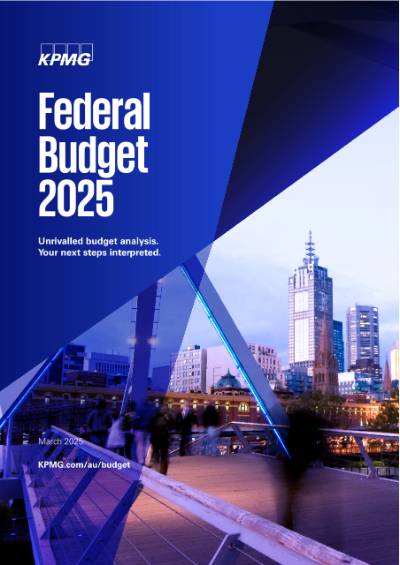On Tuesday 25 March 2025, Treasurer Jim Chalmers handed down the 2025–26 Australian Federal Budget with updates to key economic forecasts.
From personal and business tax to banking, infrastructure, health, climate change, and more, the Federal Budget has implications for every corner of the Australian economy and our position on the global stage.
Here, KPMG’s team of specialists provide unrivalled analysis following the announcement, including insights and implications across industries and businesses, with your next steps interpreted.
What does the Federal Budget mean for your business?
Get in touch to understand how we can help your organisation navigate the 2025 budget outcomes.
Federal Budget – by topic
Select a topic below to view KPMG's in-depth analysis
Executive summary
A surprise in the Budget is the unexpected personal income tax reductions commencing from 1 July 2026. The starting rate of income tax will reduce from the current 16 percent to 14 percent by 2027-28. This will cost an estimated $17.1 billion over the forward estimates period.
The Budget shows an expected deficit in the underlying cash balance for 2024-25 of $27.6 billion, or 1 percent of GDP. However, larger deficits are forecast over the remainder of the forward estimates period to 2028-29.
Federal Government net debt is expected to remain reasonably stable as a percentage of GDP at between 21 and 24 percent over the forward estimates.
Certain other forecasts over the forward estimates may be seen as relatively encouraging, with real GDP growth increasing to 2.75 percent and unemployment steadying at 4.25 percent.
The extension to the Energy Bill Relief Fund through to 31 December 2025 at a cost of $1.8 billion will be welcomed by many , as will the measures to increase the amount of Medicare bulk billing and reduce the price of medicines under the Pharmaceutical Benefits Scheme.
Support for Australian manufacturing is increased through additional funding of Australia’s metals industry, including green iron projects and assistance for transitioning to renewable energy. There is also more than $1.8 billion for road and rail transport infrastructure over the forward estimates period as part of a $17 billion 10-year program.
While the Australian Taxation Office is receiving nearly $1 billion in additional funding for compliance activities, the Budget does not signal any tax reform which may be needed to fuel Australia's future growth and to protect our competitive position globally.
It remains the case that the key to the nation’s future prosperity is productivity. We are eager to hear the further announcements expected to be made as part of the election campaign and what impact they will have on this aspect of our economy.


Get in touch and we'll help you prepare for any implications that may affect your business.
Contact usEconomic analysis
What’s in the budget?
- A forecast underlying cash balance of $42.1 billion in 2025-26; a $4.8 billion improvement on the recent MYEFO estimate.
- Nearly $85 billion of “off-budget” spending over the forward estimate period, resulting in cumulative headline cash balance deficits of $236 billion over the four years to 2028-29.
- Gross debt balloons to $1.22 trillion by the end of 2028-29, an increase of $283 billion over debt levels projected for the end of this financial year.
- Growth in government spending continues to outpace aggregate GDP growth, resulting in public sector spending as a proportion of GDP peaking at 28.5 percent next financial year; up from 24.1 percent in 2018-19.
The Treasurer has closely aligned this year's Budget deficit with the MYEFO estimate, reaching a headline cash balance of -$27.6 billion. Furthermore, the Treasurer has successfully reduced the projected deficits by $1.2 billion for the underlying cash balance and $5.9 billion for the headline cash balance.
However, despite these reductions, it appears that none of the savings are being transferred to the nation's balance sheet, with gross debt expected to remain at $1.16 trillion by the end of 2027-28, in alignment with MYEFO estimates. Additionally, overall net debt is projected to increase by over $210 billion over the forward estimate period.
Considering this economic context, the provision of tax cuts and widespread cost-of-living relief for all taxpayers and households over the upcoming years was surprising. It is important to note that these initiatives are being financed through debt, rather than windfall gains from rising terms of trade or above-average productivity. This household expenditure is compounded by a continued increase in public sector spending, elevating the role of the government sector in the economy to unprecedented levels.
These factors indicate that this budget is not focused on initiating the reforms required to secure our national finances for the future. Instead, it appears to be an election-focused budget. While current deficits and debt levels may allow this approach for a few years, the policy challenges facing the nation persist and will inevitably need to be addressed.
What does it mean for you?
- Higher levels of gross net debt, will eventually have to be paid for by future generations either through higher taxes or lower spending.
- A double income household earning $150,000 will receive $150 in electricity rebates next financial year, with lower income tax payments of $536 in 2026-27 and $1,072 in 2027-28 compared to current tax rates.
KPMG specialist

Get in touch and we'll help you prepare for any implications that may affect your business.
Contact usDemographics
Jobseeker & Youth Allowance recipients*
* Excluding Youth Allowance (student and apprentice)
Economic outlook
- Unemployment rate of 4.25% in 2025-26 reflects a strong labour market for job seekers.
- Cost of living pressures are easing, with growth in CPI expected to fall to 3% in 2025-26.
Budget outlook
- Energy bill rebates.
- Increased access to bulk billing.
Aged pensioners
Economic outlook
- Cost of living pressures are easing, with growth in CPI expected to fall to 3% in 2025-26.
Budget outlook
- Increased access to bulk billing.
- Cuts to cost of medicines on PBS.
- Energy bill rebates.
Renters
Economic outlook
- 3.25% increase in Wage Price Index in 2025-26 will boost wages.
- Cost of living pressures are easing, with growth in CPI expected to fall to 3% in 2025-26.
Budget outlook
- Tax cuts.
- Energy bill rebates.
- Increase in the maximum rates of Commonwealth Rent Assistance.
- Helping to increase supply via $1.5 billion for infrastructure, and more social housing.
Recent first home buyers
In 2024:
Economic outlook
- 3.25% increase in Wage Price Index in 2025-26 will boost wages.
- Cost of living pressures are easing, with growth in CPI expected to fall to 3% in 2025-26.
Budget outlook
- Tax cuts.
- Energy bill rebates.
- $3 billion in incentive payments under the New Homes Bonus to boost housing supply.
- Expanding the Help to Buy program for future first home buyers.
References
- Australian Bureau of Statistics (ABS), Census of Population & Housing, 2021
- Department of Social Services, Benefit and Payment Recipient Demographics, February 2024
- ABS, Consumer Price Index, December 2024
- SQM Research, National Residential Vacancy Rate, February 2024
- ABS Lending indicators, December 2024
KPMG specialist

Get in touch and we'll help you prepare for any implications that may affect your business.
Contact usIndividuals
What’s in the budget?
- 1 July 2026 is the commencement date of the additional personal income tax rate cuts and when individuals will see a further increase in their take-home pay.
- $19 billion wiped from existing HELP and student loan debts via a 20 percent reduction to all debts.
- $1.8 billion committed to combating cost of living pressures, in the form of additional quarterly energy bill rebates for over 10 million households.
- $648 million in Medicare levy relief for low income earners.
Personal income tax rates
The Budget includes a reduction to personal income tax rates.
From 1 July 2026, the 16 percent tax rate will drop to 15 percent, followed by a drop to 14 percent from 1 July 2027.
As a result, Australian taxpayers may receive an extra tax cut of up to $268 for 2026-27 and up to $536 every year from 2027-28 onwards.
| Thresholds ($) | Tax Rates 2024-25 and 2025-26 | Tax Rates in 2026-27 | Tax Rates in 2027-28 |
|---|---|---|---|
| Up to $18,200 | 0 | 0 | 0 |
| $18,201 - $45,000 | 16% | 15% | 14% |
| $45,001 - $135,000 | 30% | 30% | 30% |
| $135,001 - $190,000 | 37% | 37% | 37% |
| From $190,000 | 45% | 45% | 45% |
Whilst not referenced in the Budget, we expect the government may need to give consideration to other measures such as the low income tax super offset (LISTO) given that the marginal tax rate for individuals earning up to $45,000 is now intended to drop below the 15 percent tax rate that would otherwise apply to these individuals’ contributions into superannuation.
Medicare levy threshold changes
Consistent with previous years, to reflect the increase in inflation the government will increase the Medicare levy low-income thresholds from 1 July 2024 by 4.7 percent.
| Taxpayer | 2023-24 Threshold | 2024-25 Threshold |
|---|---|---|
| Singles | $26,000 | $27,222 |
| Families | $43,846 (plus $4,027 for each dependent child) | $45,907 (plus $4,216 for each dependent child) |
| Single Seniors and Pensioners | $41,089 | $43,020 |
| Families (Senior and Pensioner) | $57,198 (plus $4,027 for each dependent child) | $59,886 (plus $4,216 for each dependent child) |
Changes to HELP and student loan repayments
The government has committed to reducing HELP or student loan debt by applying a one-off 20 percent reduction before indexation is next applied on 1 June 2025.
The government will also increase the minimum repayment threshold for HELP and student loan debts from $54,435 in 2024-25 to $67,000 in 2025-26.
HELP repayments will now be calculated only on the income above the new $67,000 threshold, rather than repayments being based on total annual income.
Energy bill relief
The government will continue its energy bill relief measures that were due to expire on 30 June 2025 for an additional two quarters, resulting in two additional quarterly $75 energy bill rebates through to 31 December 2025.
Extension of the Personal Income Tax Compliance Program
The government’s ongoing focus on addressing non-compliance by individual taxpayers continues to be a feature of the allocation of ATO funding in the Budget.
The Personal Income Tax Compliance Program has been allocated $75.7 million over the next four years from 1 July 2025 to continue to deliver a combination of proactive, preventative and corrective activities in key areas of non-compliance.
Restricting foreign ownership of housing
Foreign persons (including temporary residents) will not be able to purchase established dwellings for two years from 1 April 2025. The ATO will be provided funding to enforce the ban.
What does it mean for you?
- Increase in take home pay from 1 July 2026 due to a reduction in the 16 percent personal income tax rate.
- 20 percent reduction of HELP and student loan balances and a revision of future repayment thresholds and methodology.
- Cost of living relief via two additional $75 quarterly energy bill rebates for households.
KPMG specialists


Get in touch and we'll help you prepare for any implications that may affect your business.
Contact usMultinational tax
What’s in the budget?
- Deferred start date of previously announced measure to expand the foreign resident capital gains tax regime.
- Deferred start date of extended clean building managed investment trust withholding concession.
- Clarifying access to concessional managed investment trust withholding rates.
- Two year expansion and a one year extension of the ATO Tax Avoidance Taskforce.
- Extension of additional 35 percent tariff on goods produced or manufactured in Russia or Belarus.
Deferred start date of the foreign resident capital gains tax measure
The government will defer the start date of the previously announced measure to broaden foreign resident capital gains taxation (announced in the 2024-25 Budget), from 1 July 2025 to the later of 1 October 2025 or the first 1 January, 1 April, 1 July or 1 October after the Act receives Royal Assent.
The measure is aimed at expanding the foreign resident capital gains tax (CGT) regime to:
- Clarify and broaden the types of assets that foreign residents are subject to CGT on;
- Amend the point-in-time principal asset test to a 365-day testing period; and
- Require foreign residents disposing of shares and other membership interests exceeding $20 million in value to notify the ATO, prior to the transaction being executed.
While the government released a consultation paper on this measure in July 2024, there has been no draft legislation released.
Deferred start date of the extended clean building managed investment trust withholding concession
The government will defer the start date of the previously announced extension of the clean building managed investment trust (MIT) withholding tax concession to data centres and warehouses that meet the relevant energy efficiency standard (announced in the 2023-24 Budget). The amended start date will be the first 1 January, 1 April, 1 July or 1 October after the Act receives Royal Assent.
Clarifying access to concessional MIT rates
Consistent with the Assistant Treasurer’s media release on 13 March 2025, the government will amend tax laws to ensure legitimate investors can continue to access concessional withholding tax rates in Australia that are available to MITs.
The announcement provides welcome clarity on the application of the ATO’s strengthened guidelines to prevent misuse of the MIT regime set out in Taxpayer Alert 2025/1 (TA 2025/1) which was released on 7 March 2025.
The proposed measure will apply to fund payments from 13 March 2025 to make clear that trusts ultimately owned by a single widely held investor are able to access the MIT concessions. The measure aims to "complement" TA 2025/1 which is focused on preventing taxpayers from engaging in non-commercial restructures to inappropriately access MIT withholding tax benefits. The amendments will not affect the ATO's power to act using Part IVA where 'captive MITs' involve other characteristics of the kind set out in TA 2025/1.
Strengthening tax integrity
The government will continue to fund the ATO’s focus on tax integrity by providing $999 million over four years to extend and expand tax compliance activities. The majority of this funding will go to the ATO’s Tax Avoidance Taskforce to scrutinise multinationals and large taxpayers.
Extension of additional tariff
The additional 35 percent tariff on imported goods that are the produce or manufacture of Russia or Belarus, will be extended to 24 October 2027.
Other previously announced measures not in the Budget
There are no further developments in relation to a number of previously announced but unenacted measures, including:
- The significant expansion of the general anti-avoidance rule to schemes that access a lower withholding tax rate or have a dominant purpose of obtaining a foreign tax benefit (announced in the 2023-24 Budget).
- New penalties for mischaracterised or undervalued royalty payments to which withholding tax would otherwise apply (announced in the 2024-25 Budget), and mischaracterised or undervalued dividends or interest payments (announced in 2024-25 MYEFO).
What does it mean for you?
- While the deferred start dates for some measures are welcome, there are still key measures not yet implemented which creates uncertainty for business, especially in light of the upcoming election.
- Multinational tax integrity remains a priority for the government, as demonstrated by the increased funding for the ATO Tax Avoidance Taskforce.
- There are decisions taken by the government but not yet announced and not for publication referred to in the Budget. Notably there are $720 million of forecasted receipts for 2028-29 which may mean there are new measures for multinationals, reserved for the election.
KPMG specialists




Get in touch and we'll help you prepare for any implications that may affect your business.
Contact usMid-market tax
What’s in the budget?
- $999 million over four years to extend and expand ATO tax compliance activities.
- The government will ban non-compete clauses that apply to workers earning less than $175,000 and will introduce other measures targeting anti-competitive practices.
- Support for brewers, wine makers and hospitality venues in the form of a pause to the indexation of draught beer excise, along with increases to excise and rebate concession caps for producers.
The ATO will receive additional funding for tax compliance activities. Focus areas will include shadow economy behaviour; non-compliance by individual taxpayers; and ensuring wealthy groups and medium and large businesses make timely payments of tax and superannuation liabilities. This, combined with increased funding targeting multinationals and larger taxpayers, shows that ATO compliance programs are expected to increase over time. As a result, businesses need to ensure that they have appropriate governance in place to meet their tax obligations.
The newly announced personal income tax cuts, whilst modest in nature and deferred in timing, when taken in conjunction with other cost of living relief measures will go some way towards boosting demand in the economy to benefit businesses, including those in the mid-market.
The measures addressing anti-competitive arrangements will provide both challenges and opportunities in a tight talent market for businesses, freeing up movement of labour, but requiring employers to revisit their employment terms. This is intended to boost productivity and reduce inflation.
The Budget provides welcome support for hospitality venues, brewers, distillers and wine producers in the form of a two year pause to the indexation on draught beer excise and excise equivalent customs duty rates from August 2025. Measures also include increases to the caps applying to excise remissions and rebates for brewers, distillers and wine producers from the current $350,000 to $400,000 per annum from 1 July 2026.
No reforms to the taxation of family trusts were announced despite various recent significant court cases creating uncertainty in this space.
There were no significant changes announced with respect to superannuation. However, given Payday Super is proposed to commence on 1 July 2026, this reform will require consideration and planning of business cashflows and processes.
The race will be on to pass measures such as Payday Super, instant asset write-off extension, non-deductibility of ATO interest charges and superannuation reforms before the impending federal election.
What does it mean for you?
- Mid-market businesses, family offices and other wealthy families should continue to focus on their tax compliance in light of increased ATO funding.
- Alcohol producers and hospitality operators will receive some welcome tax relief.
KPMG specialists




Get in touch and we'll help you prepare for any implications that may affect your business.
Contact usBusiness support
What’s in the budget?
- $2 billion over 19 years from 2024–25 for Green Aluminium Production Credits to provide production-based grants to support Australian aluminium smelters switching to renewable electricity before 2036, provided to eligible Australian Aluminium production facilities over a 10-year period.
- $1 billion over seven years from 2024–25 for the Green Iron Investment Fund to fund green iron projects through capital grants to support producers to establish or transition into low emissions facilities in Australia.
- $2 billion to recapitalise the Clean Energy Finance Corporation to invest in renewable energy, energy efficiency and low emissions technologies.
- Establishment of a new Front Door for investors with major transformational proposals, with pilot services expected to commence from September 2025.
- $45.2 million over three years from 2025–26 to support Agriculture, Fisheries and Forestry portfolio priorities including for trade and export and national food security strategy.
- $12 million over four years from 2025–26 to support and protect small businesses.
The Budget re-emphasised the government's commitment to fostering a sustainable future through its "Future Made in Australia" initiative announced in the previous Budget, albeit with a refocus on industries with a higher level of maturity and well-established production base in Australia, such as aluminium and iron ore. These investments, along with the establishment of a new Front Door for investors with major transformational proposals, signal the government's focus on transitioning heavy industries to low carbon production and supporting private sector investment in value-adding resources, to maintain Australia’s competitive edge in global markets.
There is a key focus in this Budget to strengthen the Food & Grocery Code of Conduct, as well as the development of a National Food Security Strategy and some measures to continue to support export and trade efforts across agricultural and regional communities.
What does it mean for you?
- $40.8 billion has been included in the contingency reserve for measures that either cannot be published or are yet be announced ahead of the election which may mean there is more to come in business support funding.
- The current federal Strategic Examination of R&D (SERD) means any major changes to innovation support will likely be on hold pending the Review’s recommendations.
KPMG specialists




Get in touch and we'll help you prepare for any implications that may affect your business.
Contact usSkills & workforce
What’s in the budget?
- Net Overseas Migration (NOM) is forecast to be 225,000 in 2027–28 and 2028–29. This represents a reduction in NOM from 435,000 (2023-24), 335,000 (2024-25) and 260,000 (2025-26).
- $19 billion in reduced student debt, a 20 percent reduction in outstanding student loan liabilities in the Higher Education Loan Program and other loan schemes along side changes in repayment thresholds and previously announced changes to indexation.
- $2.5 billion over 11 years (from 2024-25) covering additional university places.
- Ban on non-compete clauses for workers earning less than $175,000 together with other measures to increase productivity.
- $32.2 billion in 2025-26 for Better and Fairer School Funding to government and non-government schools in all states.
- $626.9 million over four years to reframe the New Energy Apprenticeships Program and expand it to capture ‘critical residential construction occupations’.
- $836.9 million for the next two years to support continued universal access to preschool for the year before school commences.
- $207.2 million in ongoing funding for the year 2026-27 for Free TAFE places, building on a prior commitment up to 2025-26.
Higher Education
Funding for new university places and University Accord initiatives continues as previously announced. There is little substantive new funding, with the largest key initiative being changes to student loan debts and repayment arrangements.
Early childhood, schools and skills
Education announcements largely build on already released National Partnership Agreement funding (or their equivalents), with top-up funds for immediate out-years, and ongoing funding dependent on future Commonwealth-State negotiations.
For example, further universal preschool funding beyond the current two-year commitment is dependent on a new National Partnership Agreement being agreed between the Commonwealth and States and Territories. At this stage, there is no funding for or mention of addressing recent reporting relating to early childhood quality issues.
This is also largely the case for the National Skills Agreement and associated funding.
Significant new investment over four years has been tied to new initiatives such as reform outcomes including the introduction of Year 1 phonics.
Migration
This was a holding budget for immigration with the government having released its Migration Strategy in December 2023, and the subsequent introduction of multiple immigration reforms in the twelve months up to December 2024.
Workforce
The government plans to ban non-compete clauses for low and middle-income employees (currently earning less than $175,000), aiming to boost wages and worker mobility. These clauses, which restrict workers from moving to competing employers or starting competing businesses, are found to significantly suppress wages and reduce worker mobility, especially for lower-paid workers.
What does it mean for you?
- The phased decrease in net overseas migration reflects a more targeted approach to skilled migration with implications for businesses accessing skilled foreign talent.
- University students and graduates with outstanding student loans win in this budget.
- Ongoing funding certainty beyond core funding commitments is largely dependent on future Commonwealth-State negotiations.
- Continued focus on skilling Australians to support the transition to the clean economy.
KPMG specialists




Get in touch and we'll help you prepare for any implications that may affect your business.
Contact usClimate & energy
What’s in the budget?
- $1.8 billion in more energy bill relief for households and small businesses.
- $2 billion for Green Aluminium Production Credits.
- $2 billion to recapitalise the Clean Energy Finance Corporation (CEFC).
Energy bill relief
The government prioritises cost of living support with $1.8 billion to provide $75 rebates per quarter to the end of 2025 for eligible households and small businesses.
Renewable energy and green metals
The government is providing $2 billion to re-capitalise the CEFC for the first time since it was established in 2012.
Continuing the government’s Future Made in Australia agenda, $3.2 billion will be invested in Australia’s metal industry. This includes:
- $2 billion over 19 years from 2024–25 for Green Aluminium Production Credits to transition to renewable energy.
- $1 billion over seven years from 2024–25 for the Green Iron Investment Fund, with up to $500 million to transform the Whyalla Steelworks.
Announced in last year’s budget, targeted consultation on the $1.5 billion Future Made in Australia Innovation Fund has commenced, which includes $750 million for green metals, $500 million for Clean Energy Technology Manufacturing and $250 million for low carbon fuels.
Climate resilience and disaster response
The budget includes measures to support climate resilience and respond to disasters:
- $1.2 billion has been provisioned to meet the costs associated with recent natural disasters, including ex-Tropical Cyclone Alfred and Far North Queensland floods.
- $28.8 million will be allocated over two years to boost Australia's resilience to natural hazards and disaster response, and $354 million over four years for projects that support flood resilience.
Protecting our environment
An additional $212 million over four years is allocated to protect Australia's natural environment, supporting the government’s goal to protect 30 percent of the nation’s land and waters by 2030.
What does it mean for you?
- Households and small businesses will receive energy bill relief of $150 through to the end of 2025.
- The budget implements the government’s energy and climate policies including its flagship Future Made in Australia agenda, including in green metals and hydrogen.
KPMG specialists



Get in touch and we'll help you prepare for any implications that may affect your business.
Contact usTransport & infrastructure
What’s in the budget?
- $17.1 billion for priority road and rail infrastructure projects.
- The Budget provides a strong focus on road infrastructure, including $7.2 billion for the Bruce Highway upgrades that will enhance regional productivity and job creation.
- The Budget also provides investments to support major rail projects including $2 billion for Sunshine Station as part of the Melbourne Airport Rail Link Project and $1 billion to preserve the South West Sydney Rail Corridor.
New Infrastructure commitments
- QLD $7.2 billion for Bruce Highway Upgrades
- VIC $3.0 billion, including:
- Sunshine Station ($2 billion)
- Road Blitz ($1 billion)
- NSW $2.8 billion, including:
- Terrigal Drive Upgrades ($115 million)
- South West Sydney Corridor ($1 billion)
- Townson, Burdekin and Garfield Road Upgrades ($580 million)
- Fifteenth Avenue Upgrade ($500 million)
- ACT $20.0 million for Monaro Highway Upgrade Planning
- TAS $280.0 million, including:
- Arthur Highway Upgrades ($200.0 million)
- Southern Outlet Transit Lane Extension ($80 million)
- SA $125.0 million for Curtis Road Level Crossing Removal
- WA $350.0 million for Kwinana Freeway Upgrade
- NT $200.0 million for Stuart Highway Duplication
Existing Infrastructure Investments
- QLD $200.0 million for Rockhampton Ring Road
- NSW $50 million for Homebush Bay Drive
- ACT $30.0 million for Monaro Highway Upgrade
- VIC $1.1 billion for Western Freeway
What does it mean for you?
- The Budget provides a further $15.6 billion in new investments predominantly in road and rail projects across all states and territories.
- Investment remains focused on longer term productivity improvements to increase supply chain efficiency and job creation.
KPMG specialist

Get in touch and we'll help you prepare for any implications that may affect your business.
Contact usSocial housing & real estate
What’s in the budget?
- $0.8 billion in additional investment in the Help to Buy program through increasing property price caps and increasing income caps.
- $54 million to increase supply and adoption of prefabricated and modular housing construction.
- $4.9 million over four years to continue the Regional Home Guarantee and Family Home Guarantee Schemes.
- $16 billion increase in Commonwealth’s guarantee cap on Housing Australia’s liabilities from $10 billion to $26 billion.
- $5.7 million over four years for the ATO to enforce the ban on foreign persons purchasing established dwellings.
- $8.9 million over four years for the ATO and Treasury to implement an audit program and enhance their compliance approach to target land banking by foreign investors.
- $4.6 million over four years to continue the role of the National Housing Delivery Coordinator working with State and Territory Governments to drive additional housing supply.
The government is increasing the income thresholds and price caps for its Help to Buy program for first homeowners. The previously announced scheme will look to support up to 10,000 individual and families every four years.
The government will ban foreign persons (including temporary residents and foreign-owned companies) from purchasing established dwellings for two years from 1 April 2025, unless an exemption applies. Exceptions include:
- investments that significantly increase housing supply or support the availability of housing on a commercial scale.
- purchases by foreign-owned companies to provide housing for workers in certain circumstances.
The enhanced compliance approach by the ATO and Treasury to target land banking will ensure foreign investors comply with requirements to put vacant land to use for residential and commercial developments within reasonable timeframes.
What does it mean for you?
- Increased income and price caps broadening eligibility to the government’s Help to Buy scheme to support the acquisition of new and existing homes via a shared equity scheme.
- Increased access to residential homes for Australians through tougher restrictions on foreign purchasers. Foreign investors will be encouraged to comply with requirements to put vacant land to use for residential and commercial developments within reasonable timeframes to minimise land banking.
KPMG specialists




Get in touch and we'll help you prepare for any implications that may affect your business.
Contact usHealth, ageing & human services
What’s in the budget?
- $8.4 billion for Medicare to expand bulk billing to deliver 18 million extra bulk-billed GP visits each year by 2030.
- $657.9 million to open 50 new urgent care clinics.
- $784.6 million to lower the maximum costs of medicines listed on the Pharmaceutical Benefits Scheme (PBS), down from $31.60 to $25 per script.
- $2.5 billion over five years to meet the cost of the Fair Work Commissions decision to increase wages of aged care nurses across all aged care programs.
- $1.8 billion one-off funding boost to fund public hospitals and related health services through the National Health Reform Agreement.
- $423.8 million to support inclusion and build the capacity of people with disability and their families.
The Budget is focused on delivering against the government’s commitment to reduce cost as a barrier to healthcare. This includes continued investments for initiatives aimed at strengthening Medicare.
The government is committing $8.4 billion to increase access to bulk billing. The majority of this funding, $7.9 billion over four years from 2025–26, focuses on expanding eligibility for bulk billing incentives.
The government is continuing its investment to reduce pressure on hospitals and emergency departments, with an additional $657.9 million allocated to fund 50 new urgent care clinics.
Pharmaceutical Benefits Scheme initiatives are being funded to reduce out-of-pocket costs for patients. $784.6 million is committed to cap the co-payment on medications at $25. A further $1.8 billion will fund new and amended listings, including for cancer and women’s health.
The government is investing in the sustainability of the national health system, with a one-off $1.8 billion injection into public hospitals through the National Health Reform Agreement, and a further $662.6 million over five years to strengthen and support Australia’s health workforce.
The government is committing ongoing support to the aged care workforce through allocating $2.5 billion over five years to meet the increased wage costs of aged care nurses across all aged care programs, which will be delivered through increases that will flow through program indexation. Additionally, there is an ongoing commitment to implementation of aged care reforms, with $291.6 million committed over five years.
In response to the Australian Law Reform Commission’s Inquiry into the Justice System's Response to Sexual Violence, $21.4 million has been committed over three years. These funds focus on extending pilots delivering specialist trauma-informed sexual assault legal services, extending the lived experience Advisory Group, and research to understand reasons for withdrawal of complaints and support provided during investigations.
The government is demonstrating an ongoing commitment to support people with disability and safeguard the National Disability Insurance Scheme (NDIS) through an additional $175.4 million over five years. This includes, $24.4 million dedicated to detecting and responding to fraud, addressing non-compliant payments and the NDIS Appeals Program.
To support inclusion and build the capacity of people with disability and their families, an additional $423.8 million is being committed, largely building on existing budget and resourcing from 2022-23 Budget measures. Within this, $17.1 million is committed over four years to establish the Accessible Australia initiative to increase accessibility to community spaces.
What does it mean for you?
- The Australian community will see improved access to primary healthcare services through a range of initiatives designed to increase access points and reduce out-of-pocket costs for consumers.
- Consumers will experience enhanced access to quality care and medicines through sustained investment in Medicare, Urgent Care Clinics, the PBS and public hospitals.
- Ongoing commitment to ensure older Australians receive high quality, tailored care in their home.
KPMG specialists



Get in touch and we'll help you prepare for any implications that may affect your business.
Contact usDefence & Defence Industry
What’s in the budget?
- $50.3 billion investment reiterated by government in defence by mid 2030s, forecasting defence funding will be 2.3 percent of GDP by the early 2030s.
- $11.9 million in new funding to support veterans and their families, including an extension of the Military and Veteran Psychiatry Training program for one year.
- $47.6 million to address the increased demand for downstream services following the increase in determination of veterans’ claims.
- $61.7 million for continued regulatory, safety and policy advice in support of the acquisition of nuclear-powered submarines.
- $36 million in funding for Ukraine including embassy support and artillery.
The Budget has confirmed a $50.3 billion increase in funding to the Department to be realised over the next decade, which is aligned to the third epoch within the National Defence Strategy. A total appropriation of $1.79 billion has been carried forward to FY26 into the forward estimate period.
The government has allocated $61.7 million for continued regulatory, safety and policy advice in support of the acquisition of the nuclear-powered submarine capability, distributed across multiple departments and agencies. This includes $11.1 million towards the development of non-proliferation and safeguard arrangements with the International Atomic Energy Agency and diplomatic support through DFA.
The government has extended the uplift program for the Department of Veterans’ Affairs (DVA) systems that processes Veteran claims. This Budget extends that program by $47.6 million. Veterans and their families will benefit from the $11.9 million of services, with $1 million to extend the Volunteer Training in Suicide Recognition and Intervention program for an additional year.
What does it mean for you?
- This Budget signals continuity of Defence spending priorities. Budget announcements on new opportunities for Defence Industries are limited beyond those already announced previously.
- Continuity of investment in existing programs will be welcomed, new growth opportunities will most readily be found in regional markets and further afar, particularly in European markets.
KPMG specialists



Get in touch and we'll help you prepare for any implications that may affect your business.
Contact usNational security & cyber
What’s in the budget?
- $28.8 million for disaster preparedness and recovery, including support for ex-Cyclone Alfred.
- $164.6 million for Solomon Islands Police Force.
- $156.7 million to counter trade of illicit tobacco.
- $44.6 million to implement the response to the 2024 Independent Intelligence Review.
- $36 million to return diplomatic and consular services to Kyiv.
- $20 million to support economic engagement with India.
- $28.3 million to establish a Commonwealth Parole Board.
Without Ex-Tropical Cyclone Alfred, it is unlikely this Budget would have come to fruition. Consequently, the cyclone has been a central focus of both the Budget and the Treasurer's speech. The government is confronting this fiscal reality by highlighting their record spending on natural disaster recovery this financial year. This includes targeted measures for emergency services agencies and a sensible provision of $1.2 billion over the forward estimates to cover future disaster response payments.
The Pacific region continues to be a priority for the government, with $164.6 million over four years to support growth in the Royal Solomon Islands Police Force (funding for this measure has already been provided ). This investment will assist in building Solomon Islands’ ability to meet its security needs and, importantly, attempt to re-assert Australia’s position as the security partner of choice in our near region.
The Australian Federal Police (AFP) and a number of state, territory and other federal agencies will receive a share of $156.7 million over two years to counter the illicit tobacco trade. The AFP will also receive $38.2 million over four years to fit out and sustain shared Commonwealth facilities at Western Sydney International (Nancy-Bird Walton) Airport.
While this is the first Budget in recent memory with no new money for cyber security, the government has committed $44.6 million over four years to implement the recommendations of the 2024 Independent Intelligence Review.
Funding is aimed at increasing the capacity of the Office of National Intelligence to support initial implementation of key priorities, such as a new assessment function and transformation of classification and information systems. It also includes $14.8 million over four years to enhance the National Intelligence Academy to improve the capability and connectivity of the National Intelligence Community through the delivery of training on intelligence skills.
As announced by the Foreign Minister late last year, Australia has reopened the Embassy in Kyiv, with funding included in the Budget to return diplomatic and consular services. Funding for this measure has already been provided.
The importance of India as an economic partner has been highlighted through the announcement of $20 million to support increased engagement.
The Budget also includes $28.3 million over four years to establish a Commonwealth Parole Board for federal offenders subject to a Commonwealth Parole Order.
What does it mean for you?
Consistency in current spending levels and priorities, with some targeted investment in disaster recovery, engagement with partners and bolstering the effectiveness of our core institutions.
KPMG specialists


Get in touch and we'll help you prepare for any implications that may affect your business.
Contact usTechnology & AI
What’s in the budget?
- $291.6 million over 5 years to continue the delivery of aged care reforms and implement recommendations from the Royal Commission into Aged Care Quality and Safety.
- $228.7 million in 2025-26 to continue modernising My Health Record and support the digital health reform agenda.
- $207 million over 2 years to deliver the second tranche of stabilisation and uplift of the Australian Securities and Investments Commission’s (ASIC) business registers,.
- $151 million over 4 years (and $43.8 million per year ongoing) to continue enhancements to the National Disability Insurance Agency’s (NDIA) fraud detecting information technology systems.
- $53.2 million to continue implementation of the Single Assessment System and support the staged digital implementation of the Aged Care Act 2024.
The government is erring on the side of caution when it comes to investing in digital transformation.
The Budget does not include any new funding for investment in important emerging technology fields, such as Artificial Intelligence and Quantum technologies and unlike previous years this Budget sees decreased government spending on digital transformation initiatives.
Budget measures focus on delivering technology to support the government’s legislative and regulatory reform agenda and providing ongoing funding for previously announced programs.
The government is continuing its investment to enhance health and aged care government systems. In addition to the measures announced to continue the implementation of the Single Assessment System and the staged digital implementation of the Aged Care Act, $15.6 million is also allocated to continue initiatives under the Health Delivery Transformation Program.
There is also an ongoing focus on investment to mitigate fraud risk. There is funding for the National Disability Insurance Agency (NDIA) to implement fraud detection technologies and to improve its ability to detect and respond to fraud and non-compliant payments.
The government also re-affirms its commitment to other digital transformations, including $207 million for the second tranche of stabilising and uplifting ASIC’s business registers , and $228.7 million to continue modernising My Health Record and support digital reform. It also includes $5.3 million to continue oversight of the Digital ID and Identity Verification Service programs.
What does it mean for you?
- This Budget signals the government’s ongoing commitment to establishing and enhancing the technology that underpins specific government services. This is in line with its recent approach to focus on smaller, phased implementations to reduce the risk of large-scale technology transformations.
- While government is focused on ensuring the resilience of its own systems, there is no new investment in important emerging technology fields, such as Artificial Intelligence and Quantum technologies.
KPMG specialists




Get in touch and we'll help you prepare for any implications that may affect your business.
Contact usDownload: Federal Budget 2025 analysis
Listen: Federal Budget 2025 – tax implications for business
KPMG Corporate Tax Partner Gabby Burcul and Enterprise Tax Partner Clive Bird discuss the measures announced in the Federal Government’s 2025 Budget, and in particular, what they mean for business.
Video: KPMG Federal Budget 2025 broadcast
Register to watch our recent analysis of the Federal Budget 2025.
FAQs: Federal Budget 2025
-
When was the Federal Budget for 2025 handed down? Treasurer Jim Chalmers delivered the 2025 Federal Budget on 25 March 2025.
-
Was there anything in the Budget regarding superannuation? Superannuation was not a key focus of this Budget. The Budget did report that since MYEFO, superannuation tax receipts were revised up by $9.7 billion over the five years from 2024–25 to 2028–29. The Australia Tax Office continues to work with employers to action unpaid superannuation.
-
What has happened to the instant asset write-off? The $20,000 instant asset write-off scheme has not been extended for another year in the Budget.
-
What migration forecasts does the Budget make? Net Overseas Migration (NOM) is forecast to be 225,000 in 2027–28 and 2028–29. This represents a reduction in NOM from 435,000 (2023-24), 335,000 (2024-25) and 260,000 (2025-26).
-
How is the Government delivering increased wages for aged care workers? The government has committed $2.5 billion over five years to meet the cost of the Fair Work Commission’s decision to increase the wages of aged care nurses across all aged care programs.
-
How does the Budget address National Disability Insurance Scheme (NDIS) cost pressures? The government has committed an additional $175.4 million over five years to the NDIS. This includes $24.4 million dedicated to detecting and responding to fraud, addressing non-compliant payments and the NDIS Appeals Program. It comes after the government passed legislation last year to curb the growth of the NDIS, which the 2024-25 Budget said would save $144 billion over four years.
-
What do the proposed changes to non-compete contracts mean for employers? The government plans to ban non-compete clauses for low and middle-income employees (currently earning less than $175,000), aiming to boost wages and worker mobility. It means that employers would no longer be able to restrict relevant workers from moving to competing employers or starting competing businesses.
-
Will the ‘tax cuts’ have an inflationary impact? The government’s new tax cuts will be phased over two years. They have said this will ensure the fiscal settings are consistent with inflation remaining sustainably in the Reserve Bank of Australia’s target bank.
-
How is the Budget addressing the issue of productivity? Budget measures intended to boost productivity include the changes to non-compete clauses, investment in road and rail infrastructure and continued focus on skilling Australians to support the transition to the clean economy. Productivity remains a focus of the government and achieving further gains will be key to the nation’s prosperity.
-
Are there any measures to support industry and manufacturing? The 2025 Budget contains few new measures related to industry and manufacturing and instead refocuses existing programs in favour of production, regions and small businesses. For more information, read KPMG’s Federal Budget 2025 analysis of business support measures.
-
What are the implications of the forecasted Budget deficits? The Treasurer has closely aligned this year's Budget deficit with the MYEFO estimate, reaching a headline cash balance of -$27.6 billion. Furthermore, the Treasurer has successfully reduced the projected deficits by $1.2 billion for the underlying cash balance and $5.9 billion for the headline cash balance. Going forward, reforms will likely be required to address the pressures that are adding to Budget deficits. For more information, read KPMG’s Federal Budget 2025 economic analysis.
-
How does the Budget impact the renewable energy industry? The budget implements the government’s energy and climate policies including its flagship Future Made in Australia agenda, including in green metals and hydrogen. For more information, read KPMG’s Federal Budget 2025 analysis of climate and energy measures.
-
Does the Budget prioritise modernising and digitising government service delivery? This Budget sees limited large-scale technology investment, with government spending focused on progressing in-flight digital transformation programs and enhancements to improve the resilience and user experience of health, human services and regulatory systems. For more information, read KPMG’s Federal Budget 2025 analysis of technology and AI measures.
-
Is there an appetite for structural tax reform? The Budget does not contain structural tax reform. There appears to be limited appetite for structural tax reform amongst the major parties, though there could be further announcements during the 2025 Federal Election campaign.








